The Featured Creatures collection provides in-depth profiles of insects, nematodes, arachnids and other organisms relevant to Florida. These profiles are intended for the use of interested laypersons with some knowledge of biology as well as academic audiences.
Distribution
The cabbage looper is found throughout much of the world where crucifers are cultivated, and during the summer months can be found throughout most of the United States. However, overwintering in the US apparently occurs only in the southernmost states. It is somewhat erratic in occurrence, typically very abundant one year, and then scarce for two to three years. This is likely due to the residual effects of a nuclear polyhedrosis virus, which is quite lethal to this insect. The cabbage looper is highly dispersive, and adults have sometimes been found at high altitudes and far from shore. Flight ranges of approximately 200 km (124 miles) have been estimated.
Description and Life Cycle
The number of generations completed per year varies from two to three in Canada, five in North Carolina, to five to seven in California. The generations overlap considerably, and therefore are indistinct. Development time (egg to adult) requires 18 to 25 days when insects are held at 32°C to 21°C (89.6°F to 69.8°F), respectively (Toba et al. 1973), so at least one generation per month could be completed successfully under favorable weather conditions. There is no diapause present in this insect, and although it is capable of spending considerable time as a pupa, it does not tolerate prolonged cold weather. It reinvades most of the United States and all of Canada annually after overwintering in southern latitudes. The lower limit for development is about 10°C to 12°C (50°F to 53.6°F), and temperatures of 40°C (104°F) or higher can also be lethal to some stages. In Florida, continuous activity and reproduction occur only south of Orlando. The remainder of Florida and the portion of Georgia south of Byron, as well as southeast South Carolina, have intermittent adult activity during the winter months, depending on weather. All points north of this have no winter activity.
Egg
Cabbage looper eggs are hemispherical in shape, with the flat side affixed to foliage. They are deposited singly on either the upper or lower surface of the leaf, although clusters of six to seven eggs are not uncommon. The eggs are yellowish white or greenish in color, bear longitudinal ridges, and measure about 0.6 mm (< 1/32 in) in diameter and 0.4 mm (< 1/32 in) in height. Eggs hatch in about two, three, and five days at 32, 27, and 20°C (98.6, 80.6, and 68°F), respectively, but require nearly 10 days at 15°C (59°F) (Jackson et al. 1969).
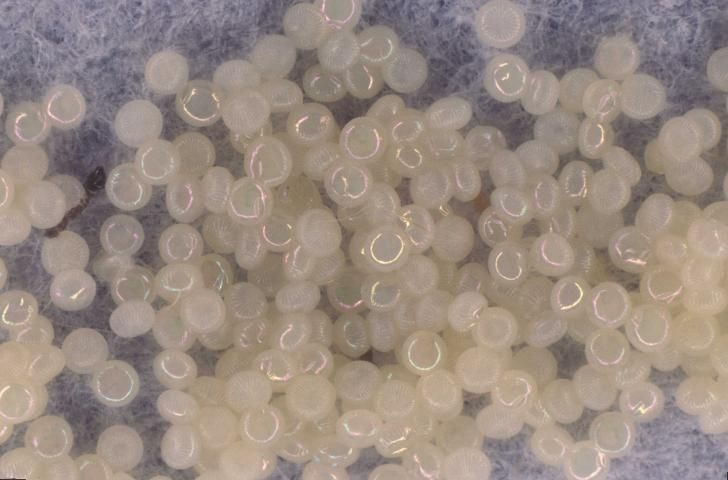
Credit: Jim Castner, UF/IFAS
Larva
Young larvae initially are dusky white but become pale green as they commence feeding on foliage. They are somewhat hairy initially, but the number of hairs decreases rapidly as larvae mature. Larvae have three pairs of prolegs, and crawl by arching their back to form a loop and then projecting the front section of the body forward. The mature larva is predominantly green but is usually marked with a distinct white stripe on each side. The thoracic legs and head capsule are usually pale green or brown. Dorsally, the larva bears several narrow, faint white stripes clustered into two broad white bands. In some cases, the mature larva is entirely green. The body is narrower at the anterior end and broadens toward the posterior. It measures 3 to 4 cm (1 1/8 to 1 ½ in) in length at maturity. Cabbage looper is easily confused with other loopers but can be distinguished from most by the presence of small, nipple-like structures (vestigial prolegs) located ventrally on abdominal segments 3 and 4. Soybean looper, Pseudoplusia includens (Walker), also has these structures, but usually has dark thoracic legs. Also, under high magnification it is possible to observe microspines on the body of soybean looper, a feature lacking from cabbage looper. The number of instars is four to seven, but many authors indicate only five. McEwen and Hervey (1960) gave mean head capsule width measurements as 0.29, 0.47, 0.74, 1.15, and 1.79 mm (< 1/32, < 1/32, < 1/32, 1/32, and 1/16 in), respectively, for instars one through five. Larval development required 17.8 and 19.9 days when reared on bean and held at 23 and 32°C (73.4 and 89.6°F), respectively. When reared on cabbage at the same two temperatures, larval development required 19.9 and 20.8 days, respectively (Shorey et al. 1962).
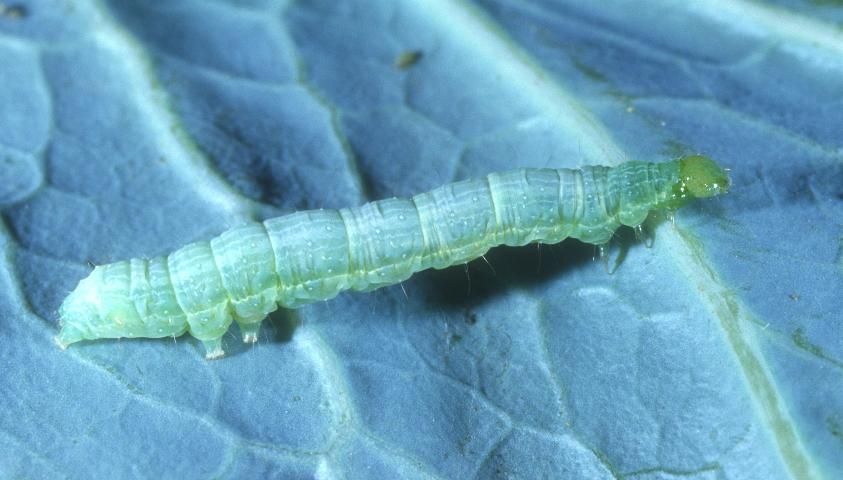
Credit: J. L. Capinera, UF/IFAS
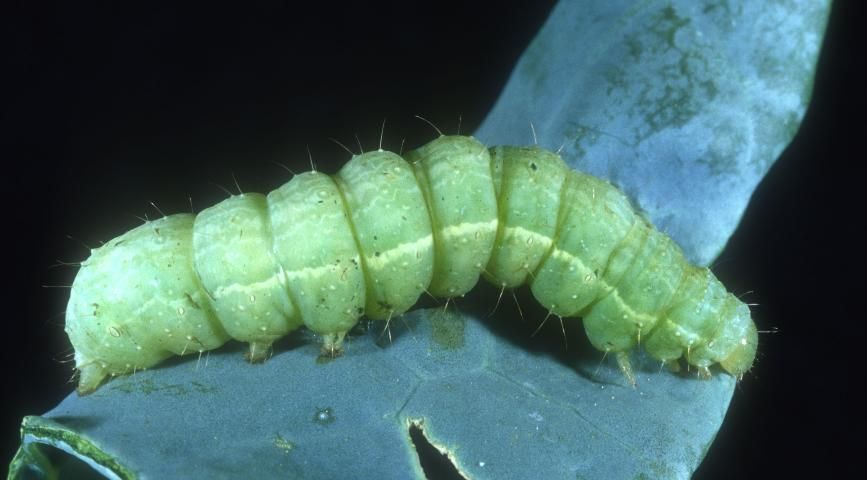
Credit: J. L. Capinera, UF/IFAS
Pupa
At pupation, a white, thin, fragile cocoon is formed on the underside of foliage, in plant debris, or among clods of soil. The pupa contained within is initially green, but soon turns dark brown or black. The pupa measures about 2 cm (3/4 in) in length. Duration of the pupal stage is about four, six, and 13 days at 32, 27, and 20°C (89.6, 80.6, and 68°F), respectively.
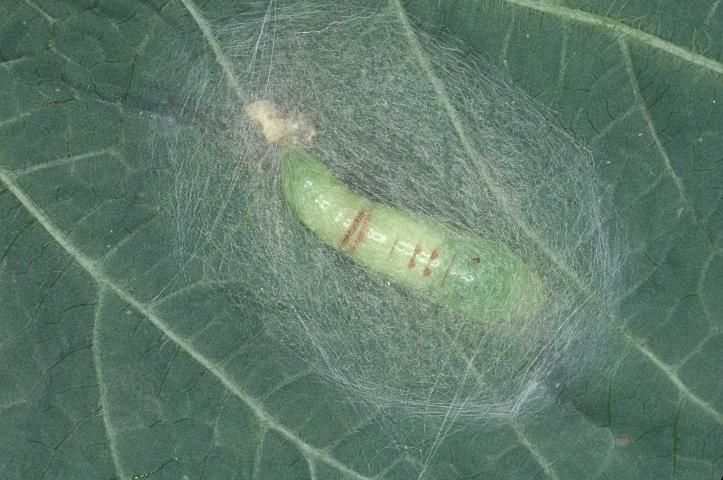
Credit: J. L. Castner, UF/IFAS
Adult
The forewings of the cabbage looper moth are mottled gray-brown in color; the hind wings are light brown at the base, with the distal portions dark brown. The forewing bears silvery white spots centrally: a U-shaped mark and a circle or dot that are often connected. The forewing spots, although slightly variable, serve to distinguish cabbage looper from most other crop-feeding noctuid moths. The moths have a wingspan of 33 to 38 mm (1 1/3 – 1 ½ in).
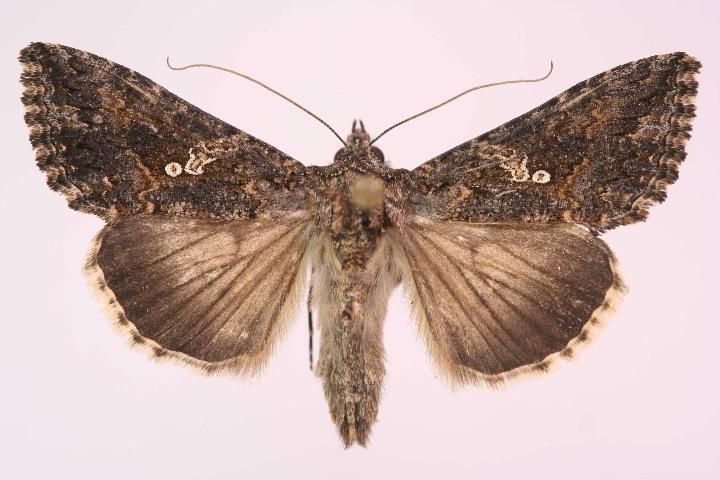
Credit: J. L. Capinera, UF/IFAS
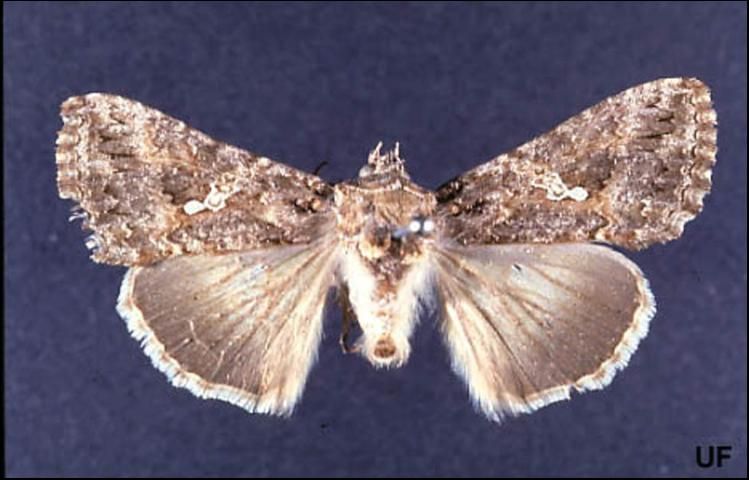
Credit: Lyle Buss, UF/IFAS
During the adult stage, which averages 10 to 12 days, 300 to 600 eggs are produced by females (Shorey 1963). Moths are considered to be seminocturnal because feeding and oviposition sometimes occurs about dusk. They may become active on cloudy days or during cool weather but are even more active during the nighttime hours. They oviposit readily at temperatures as low as 15.6°C (60.1°F), but flight activity is higher on warmer evenings.
Host Plants
The cabbage looper feeds on a wide variety of cultivated plants and weeds. As the common name implies, it feeds readily on crucifers, and has been reported damaging broccoli, cabbage, cauliflower, Chinese cabbage, collards, kale, mustard, radish, rutabaga, turnip, and watercress. Other vegetable crops injured include beet, cantaloupe, celery, cucumber, lima bean, lettuce, parsnip, pea, pepper, potato, snap bean, spinach, squash, sweet potato, tomato, and watermelon. Additional hosts are flower crops such as chrysanthemum, hollyhock, snapdragon, and sweetpea, and field crops such as cotton and tobacco. Surprisingly few common agricultural weeds are frequent hosts; among those that are suitable are lambsquarters, Chenopodium album; wild lettuce, Lactuca spp.; dandelion, Taraxacum officinale; and curly dock, Rumex crispus.
Not all hosts are equivalent for larval development and survival. Soo Hoo et al. (1984) conducted one of the most complete studies of relative suitability and reported that only about one-third of the plants tested were suitable for complete development of larvae. A survey in Alabama revealed that although cabbage looper could be recovered from numerous hosts (clover, cotton, crucifers, peanut, soybean, sweet potato, and tomato), most were found on cotton and crucifer crops.
Adults feed on nectar from a wide range of flowering plants, including clover, Trifolium spp.; goldenrod, Solidago canadensis; dogbane, Apocynum spp.; sunflower, Helianthus spp.; and others.
Damage
Cabbage loopers are leaf feeders, and in the first three instars they confine their feeding to the lower leaf surface, leaving the upper surface intact. The fourth and fifth instars chew large holes, and usually do not feed at the leaf margin. In the case of cabbage, however, they feed not only on the wrapper leaves, but also may bore into the developing head. Larvae consume three times their weight in plant material daily (McEwen and Hervey 1960). Feeding sites are marked by large accumulations of sticky, wet fecal material. Despite their voracious appetite, larvae are not always as destructive as presumed. In California studies, feeding on celery during the first one-half of the growing season did not constitute loss because these petioles were routinely stripped from the plant at harvest (van Steenwyk and Toscano 1981). With cabbage, moderate defoliation prior to head formation is similarly irrelevant. In Texas, average population densities of 0.3 larvae per plant justify control (Kirby and Slosser 1984).
Natural Enemies
The cabbage looper is attacked by numerous natural enemies, and the effectiveness of each seems to vary greatly. Most studies note the effectiveness of wasp and tachinid parasitoids, and a nuclear polyhedrosis virus (NPV). Predation has not been well studied except in cotton.
In studies conducted on collards in North Carolina, Elsey and Rabb (1970) observed considerable variation in the impact of natural enemies between years. They identified no major mortality factors until the fifth instar, despite the presence of considerable "disappearance" during this period. Either predators or weather could account for these larval deaths. During the latter instars, Voria ruralis (Fallen) (Diptera: Tachinidae), a solitary or gregarious endoparasite attacking the medium or large size larvae, was the dominant cause of death, accounting for an average of about 53% mortality. Trichoplusia ni NPV caused about 12% mortality, and undetermined fungi about 10%. Copidosoma truncatellum (Dalman) (Hymenoptera: Encyrtidae) was the other significant mortality factor but accounted for only 6-7% mortality. Copidosoma truncatellum oviposits in cabbage looper eggs, emerging from and killing the mature larvae or prepupae.
In studies conducted in California involving cabbage, Oatman and Platner (1969) reported that egg parasitism of cabbage looper by Trichogramma, while variable, could reach about 35%. Larval parasitism averaged 38.9% and tended to increase toward the end of the year. The tachinid V. ruralis was the dominant parasitoid, and was especially abundant in the autumn and winter months. The other principal parasitoids especially during summer and autumn, were Copidosoma truncatellum and Hyposoter exiguae (Viereck) (Hymenoptera: Ichneumonidae). The latter species is a solitary endoparasite that attacks small larvae. A total of 24 species of parasitoids were observed: 14 wasps and 10 flies. Despite the abundance of parasitoids, however, the authors concluded that Trichoplusia ni NPV was the key factor affecting populations.
The Trichoplusia ni NPV is well studied. Larvae normally die within five to seven days of consuming virus inclusion bodies. Early signs of larval infection are a faint mottling of the abdomen in the area of the third to the sixth abdominal segments. This is followed by a more generalized blotchy appearance, and the caterpillar eventually becomes creamy white in color, swollen, and limp. Death usually follows within hours following the limp condition, and caterpillars are often found hanging by their prolegs. Dark blotches appear after death, and the integument becomes very fragile and eventually ruptures. The body contents, heavily contaminated with new inclusion bodies, then drip onto foliage where they can be consumed by other larvae. Hofmaster (1961) reported that looper populations in Virginia were highest during dry weather because rainfall assisted the spread of NPV, and that this virus greatly suppressed loopers. In New York, Sutherland (1966) indicated that although Trichoplusia ni NPV is an important mortality factor, natural incidence does not appear to be adequate to protect crops from damage.
Management
Sampling
Various sampling strategies have been developed for cabbage looper, and many approaches include consideration of the other crucifer-feeding caterpillars. Fixed sample units of at least 40 plants are sometimes recommended. However, sequential sampling (Shepard 1973) and variable intensity sampling (Hoy et al. 1983) protocols have been developed to minimize the amount of sampling required to make appropriate management decisions. Dornan et al. (1995) recommended a binomial (presence-absence) approach because it eliminated counting and insect identification.
Blacklight traps and pheromone traps have been used in an attempt to predict looper population densities. Moth catches are monitored effectively by light traps (Hofmaster 1961), but NPV, and the spread of NPV by rain, affect looper abundance and damage, thereby reducing predictability. The cabbage looper sex pheromone has at least seven chemical components, but not all are required to elicit attraction. Pheromone releasers and blacklight traps can be combined to increase moth catches, an approach that has been studied for area-wide suppression of cabbage loopers. Although large numbers of moths have been trapped by such techniques, and insect numbers significantly reduced, suppression has not proven to be adequate to protect lettuce from damage (Debolt et al. 1979).
Insecticides
Insecticide resistance has become a problem in cabbage looper control, but susceptibility varies widely among locations. The bacterium Bacillus thuringiensis kurstacki is commonly used as a biological insecticide for suppression of this insect. There has not been much evidence of resistance to the bacterium under field conditions, but resistance occurs sporadically in greenhouses (Janmaat and Myers 2003), presumably due to greater selective pressure in the closed environment of the greenhouse. Botanical insecticides such as rotenone are less effective against cabbage looper than they are against other cabbage-feeding Lepidoptera, but neem functions as both a feeding deterrent and growth regulator. Insecticides combined with sucrose and the floral attractant phenylacetaldehyde have been shown to attract moths, which die after feeding (Landolt et al. 1991).
Biological Control
Microbial insecticides currently play a role in cabbage looper management, and their potential role has yet to be fully realized. Bacillus thuringiensis has long been used for effective suppression of cabbage looper and has the advantage of not disrupting populations of beneficial insects. Trichoplusia ni NPV is effective but has not been commercialized because of the narrow host range. Home gardeners sometimes collect loopers dying of Trichoplusia ni NPV, grind up the larval cadavers, and concoct their own effective microbial control agent. Mass release of Trichogramma spp. has been investigated for cabbage looper suppression. Looper egg parasitism can be increased several fold by careful timing of parasitoid release (Oatman and Platner 1971). Effectiveness varies among crops, however. This approach was most suitable in tomato, but also effective in crucifers and pepper (Martin et al. 1976).
Cultural Practices
Some differences in crucifer susceptibility have been observed. In New York, Dickson and Eckenrode (1975) found few significant differences, but red cabbages tended to be more resistant than kale or napa cabbage. In Wisconsin, napa cabbage, mustard, rutabaga, and turnip were less preferred for oviposition, whereas cabbage, Brussels sprouts, and collards were highly preferred. Unfortunately, there was no correlation between crops and varieties resistant to cabbage looper, and resistance to imported cabbageworm Pieris rapae (L.) (Lepidoptera: Pieridae). (Radcliffe and Chapman 1966). Among cabbage cultivars studied in North Carolina, mammoth red rock and savoy perfection drumhead cultivars are considered to be relatively resistant, but this resistance dissipated under heavy insect feeding pressure. In studies of broccoli susceptibility in Virginia, Vail et al. (1991) found that early maturing varieties were less subject to attack than were late maturing varieties. Row covers, where economically practical, are effective at preventing cabbage looper moths from depositing eggs on crops.
Selected References
Capinera JL 2001. Handbook of Vegetable Pests. Academic Press, San Diego. 729pp.
Debolt JW, Wolf WW, Henneberry TJ, and Vail PV. 1979. Evaluation of light traps and sex pheromone for control of cabbage looper and other lepidopterous insect pests of lettuce. USDA Technical Bulletin 1606. 39 pp.
Dickson MH and Eckenrode CJ. 1975. Variation in Brassica oleracea resistance to cabbage looper and imported cabbage worm in the greenhouse and field. Journal of Economic Entomology 68:757–760.
Dornan AP, Sears MK, and Stewart JG. 1995. Evaluation of a binomial model for insecticide application to control lepidopterous pests in cabbage. Journal of Economic Entomology 88:302–306.
Elsey KD and Rabb RL. 1970. Analysis of the seasonal mortality of the cabbage looper in North Carolina. Annals of the Entomological Society of America 63:1597–1604.
Hofmaster RN 1949. Biology and control of the potato tuberworm with special reference to eastern Virginia. Virginia Truck Experimental Station Bulletin. 111:1826–1882.
Hoy CW, Jennison C, Shelton AM and Andaloro JT. 1983. Variable-intensity sampling: a new technique for decision making in cabbage pest management. Journal of Economic Entomology 76:139–143.
Jackson CG, Butler, Jr. GD and Bryan DE. 1969. Time required for development of Voria ruralis and its host, the cabbage looper, at different temperatures. Journal of Economic Entomology 62:69–70.
Janmaat AF and Myers J. 2003. Rapid evolution and the cost of resistance to Bacillus thuringiensis in greenhouse populations of cabbage loopers, Trichplusia ni. Proceedings of the Royal Society B. Biological Sciences 270:2263–2270.
Kirby, R.D. and J.E. Slosser. 1984. Composite economic threshold for three lepidopterous pests of cabbage. Journal of Economic Entomology 77:725–733.
Landolt PJ, Lenczewski B, and Heath RR. 1991. Lure and toxicant system for the cabbage looper (Lepidoptera: Noctuidae). Journal of Economic Entomology 84:1344–1347.
Martin PB, Lingren PD, Greene GL, and Ridgway RL. 1976b. Parasitization of two species of Plusiinae and Heliothis spp. after releases of Trichogramma pretiosum in seven crops. Environmental Entomology 5:991–995.
McEwen FL and Hervey GER. 1960. Mass-rearing the cabbage looper, Trichoplusia ni, with notes on its biology in the laboratory. Annals of the Entomological Society of America. 53:229–234.
Oatman ER and Platner GR. 1969. An ecological study of insect populations on cabbage in southern California. Hilgardia 40:1–40.
Oatman ER and Platner GR. 1971. Biological control of the tomato fruitworm, cabbage looper, and hornworms on processing tomatoes in southern California, using mass releases of Trichogramma pretiosum. Journal of Economic Entomology 64:501–506.
Radcliffe EB and Chapman RK. 1966. Varietal resistance to insect attack in various cruciferous crops. Journal of Economic Entomology 59:120–125.
Shepard, M. 1973a. A sequential sampling plan tor treatment decisions on the cabbage looper on cabbage. Environmental Entomology. 2:901–903.
Shorey HH 1963. The biology of Trichoplusia ni (Lepidoptera: Noctuidae). II. Factors affecting adult fecundity and longevity. Annals of the Entomological Society of America 56:476–480.
Shorey HH, Andres LA, and Hale RL. 1962. The biology of Trichoplusia ni (Lepidoptera: Noctuidae). I. Life history and behavior. Annals of the Entomological Society of America. 55:591–597.
Soo Hoo CR, Coudriet DL, and Vail PV. 1984. Trichoplusia ni (Lepidoptera: Noctuidae) larval development on wild and cultivated plants. Environmental Entomology 13:843–846.
Sutherland DWS. 1966. Biological investigations of Trichoplusia ni (Huebner) and other Lepidoptera damaging cruciferous crops on Long Island, New York. New York (Cornell) Agricultural Experiment Station Memorandum 399. 99 pp.
Toba HH, Kishaba AN, Pangaldan R, and Vail PV. 1973. Temperature and the development of the cabbage looper. Annals of the Entomological Society of America 66:965–974.
Vail KM, Kok LT, and McAvoy TJ. 1991. Cultivar preferences of lepidopterous pests of broccoli. Crop Protection 10:199–204.
van Steenwyk RA and Toscano NC. 1981. Relationship between lepidopterous larval density and damage in celery and celery plant growth analysis. Journal of Economic Entomology 74:287–290.